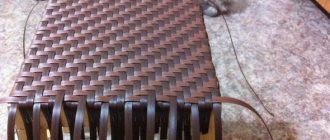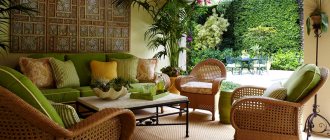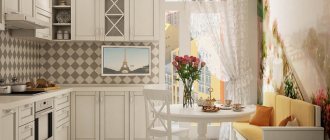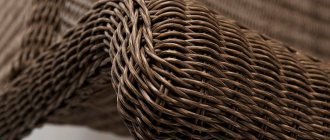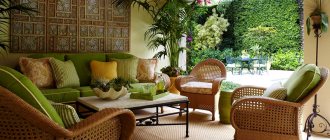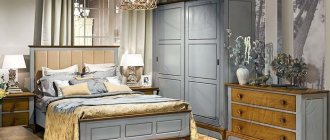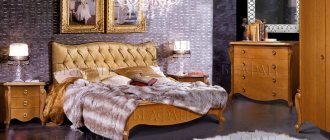Wicker furniture for a country area is always in fashion - it is an original product for a luxurious interior. To create wicker furniture with your own hands, as in the photo, you need to learn, like other modern technologies. It is preferable to start small, developing skills on simple materials.
Weaving a set of furniture with your own hands is not just an interesting activity, but also an excellent reason to be proud of your friends and, of course, an interesting topic for business.
Features of wicker furniture
The history of wicker furniture goes back thousands of years. Archaeologists often find it all over the world. Weaving from vines and other natural materials of plant origin was common in settlements located near bodies of water. The proximity of suitable raw materials in large quantities contributed to the fact that people made most of the products used in everyday life on their own.
Wicker furniture was used more often in the homes of the poor, as the cheapest and most accessible option. But quite quickly wealthy people and representatives of the nobility appreciated its beauty, functionality and possibilities of use in the interior. Since then, not only single craftsmen, but also entire artels, and later factories, have been engaged in weaving. There are even special schools of wicker weaving.
Prince Golitsyn brought the fashion for wicker furniture to Russia. Often traveling abroad, he appreciated the properties of wicker products and created an entire workshop for their production on his estate.
Wicker furniture can be a real work of art
Nowadays wicker furniture is very popular. Making it becomes a favorite hobby for many, even generating income. In addition, it has many advantages. These include:
- low cost, especially compared to products made from other natural materials;
- light weight, thanks to which you can easily move the furniture anywhere without outside help;
- environmental friendliness: wicker interior items not only look beautiful, but are also safe for health and do not have a specific odor;
- easy care: most often it is enough to wipe off dust from the furniture with a cloth dipped in water;
- durability, subject to high-quality weaving, performed according to all the rules.
True, there are also disadvantages that need to be taken into account. Furniture woven from wicker and similar materials is not resistant to the vagaries of the weather. In heavy rain it gets wet, and with prolonged exposure to sunlight and high temperatures it can dry out. This leads to loss of shape and disruption of the weave. Repairing a damaged product is very difficult. Therefore, it is not recommended to keep such furniture in open areas for a long time.
Nowadays wicker furniture is very popular, and many people are starting to make it at a professional level.
Types of wicker furniture
According to the structure and manufacturing principle, wicker furniture is divided into several types:
- Frameless products. In them, the rigidity of the structure is ensured by strong stick-ribs.
- Frame furniture, in which the body is made of durable material, such as steel rods. The metal parts of the frame are braided with wicker or other appropriate material.
- Wooden furniture in which the supporting frame is made of wooden sticks that impart rigidity and durability.
Pieces of furniture made of wicker or rattan - photo gallery
It is impossible to imagine a summer garden without comfortable pieces of wicker furniture
A rocking chair is the dream of anyone who loves comfort
Even a bed and an entire bedroom set can be woven from wicker or rattan
A cozy basket chair with a low base will appeal to kids and pets
A comfortable rattan hanging chair is a good place to relax after a hard day.
An airy openwork set of a sofa, armchairs and table will decorate any dining room
Video: wicker furniture made of wicker and rattan in the interior
Materials for creation
Plants with elastic branches are available in many regions, but it is preferable to choose natural branches of local origin. In certain areas, furniture items are made from seaweed, as well as plant leaves.
In Africa, bamboo, reed, palm branches, rattan, and other types of vines are used. In European countries, experts give preference to cattail, blackberry stems, willow, bird cherry and similar flexible stems that grow in a certain area.
The most pliable material for creating wicker furniture is rattan. It is moisture resistant and perfect for furniture frames.
Tools for work
Weaving from wicker is a labor-intensive task that requires scrupulousness. You just can't do it with your hands. You will have to stock up on a whole set of tools:
- special knives and garden shears for cutting and trimming twigs;
- ladder for sorting raw materials;
- large capacity, tank for soaking the rod;
- boiler for cooking and bleaching workpieces;
- squeezers for cleaning twigs from bark;
- splitters for dividing rods into parts;
- shof for obtaining planed strips;
- shmyg for figure processing, notching;
- iser for aligning rows;
- jigs for straightening frame blanks;
- pruner;
- measuring accessories - ruler or tape measure;
- pliers;
- saw on wood.
Types of frames
The frame is the key to the strength and durability of wicker furniture. Frame products are made faster, last longer, and use less flexible natural raw materials. The following materials can serve as a rigid base for a wicker chair:
- wooden beams;
- metal rods or tubes;
- lightweight polyurethane foam.
As for the shape of the frame, there are not so many variations in its execution. The master achieves originality only later, when he begins to weave a rigid base, using all his skill and power of imagination.
Weaving patterns and methods
There are several ways to weave furniture and interior items. Each combines decorativeness and functionality.
Weaving patterns - table
| Name of weaving | Peculiarities | |
| Solid thick | Simple |
|
| Rope |
| |
| Checkers |
| |
| Openwork | Diamond-shaped | The weaving is complex, creating geometric shapes and open cell patterns. |
| In the form of columns | ||
| Chess | ||
| Rosette | ||
| Ring | ||
| Spiral | ||
| Pigtail | The method is used for weaving decorative elements and in the design of edges. | |
| Bending | This type of weaving is used to decorate the edges of the product. | |
Weaving methods - photo gallery
This simple weaving pattern is easy for beginners to master.
The edges of the product are often braided
Rope weaving is created from two or more rods
Openwork weaving will give the product lightness, airiness and transparency.
Using checkerboard weaving, you can decorate furniture with a three-dimensional pattern.
Tips for beginners
Before you start making furniture from wicker, you need to master the basic techniques and methods of weaving, which can be done in 1, 2, 3 and 4 rods, straight, oblique, spiral. The main techniques of simple weaving are braid, rope, braid, herringbone. Openwork can be done with a cross, a diamond, an oval, a wave, or an angle. To make one product, all the techniques are unlikely to be needed, so it is better to master the minimum set perfectly, and then gradually expand it. Beginners should not start with openwork weaving, it is more difficult. To begin with, it is better to practice weaving dishes in order to master and consolidate the techniques. For example, the flat bottom of a basket and the top of a round table are woven using the same principle.
The textbooks recommend making a simulator - inserting a series of thick standing rods along the edge of a wooden block. For a simple weave with 1 rod, their number should be odd, for a checkerboard with 2 rods - even. On the simulator, you can first practice using a rope or braid instead of a vine to understand the principle of operation, and then move on to the rods.
Finishing wicker furniture
When a chair, table, sofa or other item is ready, all that remains is to give the item a marketable appearance. Finishing work is carried out in several stages:
- Inspection for various defects, eliminating them: correct the uneven density of the weaving by slightly moving the rods, align the legs, cut off the tips of the rods and smooth out the unevenness with fine-grained sandpaper.
- Bleaching and painting. To make the product white, it is treated with lime or sulfur dioxide. To give a different color, use regular paint. They also use decoctions of onion peels, wolf berries, heather, alder bark or moss, if you like naturalness and environmental friendliness.
- Varnish coating. In order not only to preserve the texture of the material used, but also to make it even stronger, apply 2-3 layers of varnish (each subsequent after the previous one has completely dried).
Step-by-step launch instructions
From writing a business plan for production to selling the first batch of finished furniture, 7 consecutive steps should be taken:
- Opening an individual entrepreneur. It is necessary to register a legal entity with a simplified taxation system. If raw materials are procured independently, then it is beneficial to use the “Revenues 6%” system, and when purchasing materials – “Revenues minus expenses 15%”.
- Renting premises. For preparing the material and weaving, a room with an area of 10 square meters, dry, clean, heated, with a water supply and sewage system is suitable. If the size of the home workshop is insufficient, some processes can be performed under a canopy, for example, boiling down twigs in bathtubs and peeling bark. With a full production cycle, it is necessary to provide a place for storing raw materials and a drying workshop for products.
- Procurement or purchase of raw materials. In production, sticks 100 cm long are used as a frame and vines 2 m long for weaving. They are stored and purchased in bundles of 100 pieces; during transportation, it is not advisable to bend the rods and expose them to moisture.
- Purchase of equipment. The weaver's workplace is equipped with a workbench, a comfortable chair, and a box for storing tools. Electrical equipment: drill, jigsaw, screwdriver and consumables for them are purchased in electrical goods stores, hand tools: pruners, knives, scissors - in departments for gardeners, but special tools for wicker weaving are practically not offered for sale. It is made independently on a lathe or ordered to be manufactured according to drawings and diagrams that can be found in textbooks and the Internet.
- Purchase of consumables. If the production cycle provides for subsequent processing of finished products, then it is necessary to purchase stains, varnishes of various shades, and anti-moisture treatment compounds. The entire range of consumables for processing vines is presented at construction wholesale stores.
- Production. Making wicker furniture yourself takes several days, depending on the size and complexity of the design. For example, in a week you can make two rocking chairs or three simple benches. To increase production volumes, it will be necessary to find and train personnel, additional costs for taxes and premises for storing finished products.
- Marketing and sales. The first steps in selling ready-made furniture are the creation of a high-quality business card website, printed catalogs, advertising brochures offering the production of unique items to order. When expanding production, it is possible to conclude contracts for wholesale supplies to furniture stores, and work on order with design bureaus. Entrepreneurs who manufacture products for children must obtain a quality certificate for the product before concluding a sales contract.
Caring for wicker and rattan products
Wicker furniture requires special care, which is due to the characteristics of the material used: wicker and rattan can become very fragile if not used correctly.
- At least once a week, wipe off dust from products with a damp cloth.
- If a large amount of water gets on wicker furniture, first wipe thoroughly with a dry cloth, then take it out into the air to allow the product to dry naturally. Do this immediately.
- Vacuum wicker items only using soft attachments.
- If you notice that the braid has begun to dry out, spray it with linseed oil from a spray bottle.
- To protect wicker furniture from moisture, treat it with tung oil or tung-based products twice a year. Do this at the beginning of the season (before moving furniture outside) and at the end.
To protect wicker furniture from high humidity, treat it with tung oil-based products.
Wicker furniture is a rather difficult product to repair. In the event of a breakdown, it is difficult to find a repairman who will undertake the repair. Therefore, proper care is mandatory and necessary for products made from wicker and rattan.
What goes with it?
Photos of wicker furniture can be viewed below. These designs are polynomials, so it is possible to fit them into different interior or exterior styles. Country furniture is considered the most popular, since in nature it is most important to use items made from natural materials.
Before purchasing wicker furniture from Italy or other countries, you should study the recommendations of professional designers:
- It is not recommended to use wicker products for classic interiors or retro-style rooms, but sophisticated designs made from newspaper tubes are well suited for them;
- a set of wicker furniture fits perfectly into different southern styles, for example, maritime or colonial;
- Such products combine well with other similar designs made from natural materials;
- if they are purchased for the living room, then this room should be intended exclusively for relaxation, but storage of things should be organized in another room.
This type of furniture is combined with various other interior items made from a variety of materials. The set of items looks great, as all the elements combine well with each other.
In what interior styles are wicker chairs appropriate?
Wicker chairs are good in almost any interior; interesting options can be found in different style directions:
- Country. Items made from natural materials in a rustic style will be very useful. Products woven from rattan or wicker are appropriate.
- Provence. Elegant provincial style, the motto of which is nobility and simplicity. Openwork light chairs with simple weaving made of light (sand, straw shades) material will ideally complement the decor without cluttering up the space.
- Pop Art. The style goes well with wicker furniture, made in an unusual shape, painted in bright colors.
- Safari style. Close to nature, loves everything natural. Chairs woven from wicker, bamboo or rattan, trimmed with leather or fur, will harmoniously fit into such an interior.
- Classic style. Prefers light-colored items with clear, symmetrical contours and elegant weaving. Chairs can be massive; wicker chairs or half-chairs are perfect.
- Loft. The style is a little rough; the simplest forms with simple weaving are chosen for it. Such products balance the deliberate “roughness” of the rest of the decor.
- High tech. Even in this direction there are wicker-type models. The chairs are complemented with metal chrome elements and have an unusual futuristic shape.
- Minimalism. The style gravitates towards simplicity, strict lines, natural materials, and discreet natural colors. Therefore, a wicker chair with minimal finishing will not be out of place here.
Handmade furniture always stands out against the background of standard furnishings.
The design of some items is unique and classifies them as true works of art. Products created from twigs of various natural materials distract from the everyday bustle of a big city and seem to transport you to a cozy country house; they set you up for relaxation and give peace. © 2022 — 2022 Furniture-one.ru — Copying of materials is strictly prohibited.
What to look for when choosing
Among the wicker furniture offered on the furniture market there are many low-grade products that are not worth the money asked for them. Clear signs indicating that the buyer is facing a low-quality product:
- Numerous seams with one joint.
- In some places the rods are broken.
- Traces of glue coming out from all sides catch your eye.
- A chair or other object is painted with an uneven layer, and the same can be said about the applied varnish. Numerous smudges are noticeable.
Also, when choosing wicker chairs, you need to clearly understand where exactly they will be used.
Products that are planned to be used to decorate a garden or balcony should be more resistant to aggressive influences - not be afraid of dampness, temperature changes, or open sun. Less stringent requirements apply to “home” chairs.
